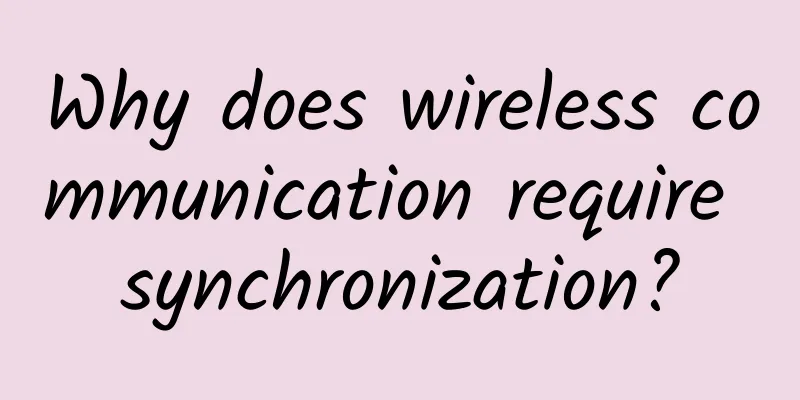Why does wireless communication require synchronization?

|
This article is reprinted from the WeChat public account "Wireless Deep Sea", written by Fei Caicai. Please contact the Wireless Deep Sea public account to reprint this article. 1. Why do wireless communication networks need synchronization? Wireless networks are composed of base stations one by one. The coverage and capacity of a single base station are limited, so various signaling interactions are required between base stations to implement complex operations such as cell selection, reselection, switching, load balancing, and interference coordination. 5G base station network diagram In order for each base station to exchange information, in addition to being able to understand each other's signaling, they also need to be in step with each other, accurately know each other's current status, and predict the actions that will occur at the next moment in order to cooperate well. Let's take 5G as an example. In TDD mode, time is used to distinguish uplink and downlink, and base stations need to be strictly synchronized. If adjacent base stations do not use the same time reference, one is transmitting downlink while the other is receiving uplink, the signal from the transmitting base station will enter the receiving base station, causing strong interference and the system will not be able to operate at all. As shown in the figure below, a 5G uplink and downlink transmission cycle includes several downlink time slots, several uplink time slots, and a flexible time slot in the middle (also called a special time slot or S time slot) as the uplink and downlink switching point. Each base station must strictly adhere to this rhythm to transmit data under clock synchronization. 5G frame structure Therefore, "synchronization" is the basis for the normal operation of all wireless networks. 2. What are frequency synchronization and phase synchronization? Synchronization, literally speaking, means that two or more quantities that change over time maintain a certain relative relationship during the change process. What kind of relative relationship is it? Generally, it is divided into two levels: "frequency synchronization" and "phase synchronization" according to the closeness of the relationship. Frequency synchronization means that the changing frequencies of the clocks of two base stations are consistent, but the phases are not necessarily consistent, and a relatively fixed difference can be maintained. Assume that there is a clock inside each of the two base stations. At a certain moment, the time indicated by clock A is 12:15 and the time indicated by clock B is 11:45. Obviously, their times differ by 30 minutes, that is, they are out of phase. At the next moment, the time indicated by clock A is 12:25 and the time indicated by clock B is 11:55. Although they are out of phase, the time difference is still 30 minutes. If the time of the two clocks always differs by 30 minutes at other times, it can be considered that they are running at the same speed and are frequency synchronized. Phase synchronization means that the phases of the clocks of two base stations always remain consistent. Taking watch A and watch B as an example, under phase synchronization, the time they indicate is exactly the same at all times. Not only must they run at the same speed, but no time difference is allowed. Therefore, phase synchronization is also called "time synchronization". It can be seen that the requirements for phase synchronization are much higher than those for frequency synchronization, and frequency synchronization is the basis of phase synchronization. The accuracy of frequency synchronization is measured by the frequency deviation or frequency stability. The unit is ppm, which stands for part per million, and is dimensionless. It indicates the allowable deviation value at a specific center frequency. The smaller the value, the higher the synchronization accuracy. The conversion relationship between ppm and Hertz is as follows: △f = (f*ppm)/10^6 Here ppm is the maximum change value (+/-), f is the center frequency (Hz), and △f is the maximum allowable frequency change range. For example, if the system clock frequency is 100MHz, the allowable frequency error is 100ppm, and the frequency change is 10kHz using the above formula. Then the maximum acceptable frequency of the system is 100.01MHz, and the minimum is 99.99MHz. The unit ppm is a bit large, and sometimes ppb is also used. The full name of ppb is parts per billion, which means one billionth. 1 ppb is one thousandth of 1 ppm, that is: 1 ppm = 1000ppb. The way to represent phase synchronization is much more direct, using time as the unit, usually expressed in microseconds (us). After all, phase and time are closely related, and phase synchronization is also called time synchronization. 3. What are the different requirements for synchronization accuracy for different network standards? Different wireless standards have different requirements for frequency synchronization and phase synchronization, as shown in the following table. Synchronization requirements for different wireless access technologies (2/3/4G) In general, technologies using FDD duplex mode, such as GSM in 2G, WCDMA in 3G, and LTE FDD in 4G, only require frequency synchronization with an accuracy of 0.05ppm (or 50ppb); while technologies using TDD duplex mode, such as TD-SCDMA in 3G, LTE TDD in 4G, etc., require more stringent phase synchronization, with an accuracy of generally ±1.5us. CDMA is a special case. Although it uses FDD duplex mode, its long and short codes are both m-sequences. Different m-sequences are distinguished by phase, so each base station requires strict phase synchronization. For 5G, the duplex mode varies depending on the frequency band. Currently, TDD is the main mode and FDD is the auxiliary mode. Therefore, phase synchronization is also required between different base stations. The synchronization accuracy requirements for its basic services are basically the same as those for 4G. However, some advanced features of 5G may also require collaborative enhancement between cells within a site or even between sites, so that the data of the same user can be sent and received through different active antenna units (AAUs), and multiple signals can be merged in overlapping coverage areas, thereby effectively improving service bandwidth. These advanced functions have put forward more stringent requirements on synchronization accuracy. Among them, the time deviation requirement for multiple-input multiple-output (MIMO) and transmit diversity technology is 65ns, and for intra-band continuous carrier aggregation (CA), the time deviation requirement for low-frequency base stations (Sub 6G) is 260ns, and the time deviation requirement for high-frequency base stations (Above 6G) is 130ns. Source: IMT-2020 Promotion Group, 5G Synchronous Network Architecture and Key Technology White Paper In addition, a variety of new services supported by 5G networks may also have high-precision synchronization requirements, including high-precision positioning services, high-speed mobile service coverage, precise measurement of service delays, and various vertical industry applications (such as the Internet of Things, Internet of Vehicles, and smart manufacturing). For example, to meet 3m positioning accuracy, the air interface signal synchronization deviation between base stations is required to be ±10ns; to meet m-level positioning accuracy, the air interface signal synchronization deviation between base stations is required to be ±3ns. In summary, high-precision phase synchronization will become the key foundation for the 5G network to perform well. |
<<: Why does the phone clearly show 5G signal but is occupying the 4G cell?
>>: Chrome downloads are so annoying! Here's how to fix it
Recommend
Wu Hequan: The proportion of IPv6 traffic in domestic applications still needs to be improved
At the "2020 China IPv6 Development Forum&qu...
Summary of the "thread" model in IO flow
1. Basic Introduction In the IO flow network mode...
Witnessing the first step of 5G network construction: antenna and feeder integration
The coexistence of multiple standards and frequen...
[Black Friday] HostHatch: $29/year-dual-core/4GB/50G NVMe/5TB/1TB/Los Angeles and other data centers
HostHatch has launched the 2023 Black Friday even...
5G promotes the development of industrial Internet, and we need to pay attention to these two points in the future
The Industrial Internet is the key cornerstone an...
A brief history of the development of the iSCSI storage protocol
iSCSI stands for Internet Small Computer System I...
In the era of industrial digital transformation, how to provide "privately customized" services for industrial networks?
[51CTO.com original article] In recent years, whe...
Why Thread will unify IoT communication protocols in the future
Various devices connected to the Internet of Thin...
The global 6G competition has quietly begun
Recently, at China Mobile's 2021 Science and ...
The number of 4G users of the three major operators is nearly 1.3 billion, and the total number of fixed-line broadband users is 476 million.
Data released by the Ministry of Industry and Inf...
A seminar on hypertension prevention and control was held, and Omron helped China to upgrade its hypertension management to a smart level
On December 5, 2019, the "To the Classic, Cr...
Edge Data Centers and the Impact of 5G
A new category of data center will become a major...
[6.18] UCloud Kuaijie cloud server starts from 5 yuan, COM domain name starts from 20 yuan, 100GB CDN traffic package starts from 1 yuan
UCloud (UCloud Technology Co., Ltd.) is also a fa...
Siemens Industrial Network Experts Plan to Build a Digital Industrial Ecosystem, 5G+TSN Will "Weave" a New Industrial Communication Network
[51CTO.com original article] On July 16, Siemens ...
Aruba Launches ArubaESP, the Industry’s First Cloud-Native Platform for the Intelligent Edge
Aruba, a Hewlett Packard Enterprise company, today...









